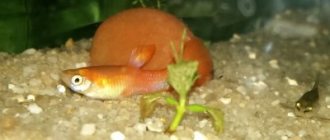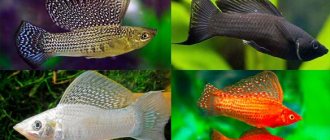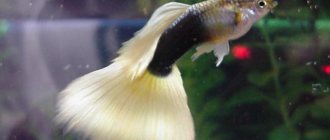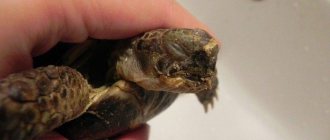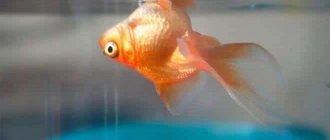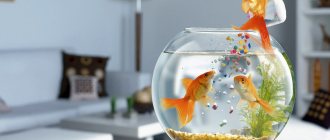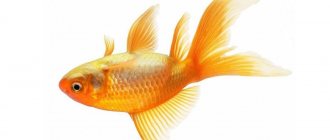For some fish species, lying on the ground or hiding in bottom decorations is a common behavior. This is typical for catfish, loaches, knives, some species of cichlids and labyrinths. For some fish, a change of location from the middle and upper layers of water to the bottom is associated with the breeding season: preparing a place for spawning and protecting the laying of eggs. For others, such as neons, the bottom layers are a place of rest and sleep. But if lying on the bottom is not typical for your pet, it is worth analyzing the possible reasons for this behavior.
Shock
Shock is understood as a physiological state of the body caused by a sudden change in a number of environmental factors.
Signs:
- rapid or slow breathing;
- decreased color brightness, pallor of the integument;
- the fish lies on the bottom and periodically moves sharply to another place.
Most often, shock occurs in fish that have just been released into the aquarium. Another reason is a sharp change in the composition of the water:
- the water was not properly prepared;
- taken from a new source;
- the result of using aquarium chemistry and medications;
- introducing new soil into the aquarium, large decorations that have not undergone proper processing.
Even without significant changes in water parameters, fish may show symptoms of shock when first introduced into a new aquarium, especially after long-term transport. This is their reaction to the new environment. This syndrome is called “launch shock.”
What aquarium fish swim in the bottom layers of the aquarium?
Let us immediately note that for some species of fish it is common to lie or swim slowly near the very bottom of the aquarium. Thus, speckled catfish and other varieties of corydoras swim in the bottom layer of reservoirs. These individuals are the orderlies of the aquarium. They eat organic particles from the bottom and scrape out algae that have accumulated on its surface.
Neons also live in the lower layers of the aquarium - bright schooling beautiful fish with iridescent scales. Swimming closer to the bottom, this type of fish feels comfortable and safe.
gold fish
Fish of the cichlid and loach families often spend time at the bottom of reservoirs and aquariums. They love to loosen the bottom in search of food and dig up aquatic vegetation. In addition, by wallowing in gravel and sand, fish thus cleanse their scales of mucus.
Many species of fish sink to the bottom of the aquarium or drift slowly in the lower layers of water at night. This is quite normal. During the day, fish lead a more active lifestyle than at night.
If goldfish sink to the bottom of the tank, this behavior is typical of new individuals that have recently been introduced into the aquarium. For several days the fish will adapt to the new environmental conditions and conditions. As a rule, adaptation takes place in secluded corners of aquariums. In the first weeks, cichlids, goldfish, labyrinth fish, and carp-toothed fish prefer to live at the bottom.
Swim bladder dysfunction
There is an important organ in the anatomy of fish - the swim bladder. These are special bags filled with gas. With the help of a bladder, the fish controls its buoyancy and can stay at a certain depth for a long time without any effort. Its deformation or damage is not fatal, but the fish will no longer be able to lead a full life without restoring the function of this organ.
Signs:
- the pet lies on the bottom and has difficulty getting up to get food;
- when moving, falls to one side;
- works intensively with its fins, swimming as if with a load.
Causes of damage to the swim bladder:
- mechanical, usually injury during transportation;
- the result of the development of a bacterial infection;
- the result of poor nutrition;
- indigestion.
The last two reasons are the most common. The fish eats too much air along with the food, which causes the stomach to swell. The pet systematically overeats. This leads to obesity, enlarged liver, cysts develop in the kidneys and ultimately leads to the growth of these organs and compression of the swim bladder.
In some ornamental forms of goldfish and Siamese fighting fish, the swim bladder can be severely deformed during the selection process, and, as a result, is vulnerable to this type of damage.
Causes
For some fish - for example, catfish and loaches - resting on the bottom or even lying on their side is completely normal. Some fish that are active during the day (such as many cichlids) tend to rest on the bottom after dark. In cases where lying on the bottom is an abnormal behavior for fish, it is often accompanied by respiratory distress (shortness of breath or rapid breathing). This phenomenon may be due to any of the reasons listed below.
- Shock, including temperature shock, nitrate shock, pH shock and osmotic shock.
- Acidosis or alkalosis.
- Swim bladder dysfunction. This problem can be caused by injury or a bacterial infection of the swim bladder. Swim bladder dysfunction can also occur as a result of certain diseases - such as dropsy, bloat, fatty liver, general obesity. It may also be a genetic problem. If the fish is clearly suffering (swimming is extremely difficult) and after two or three days there is still no sign of recovery, then the only humane option is euthanasia (painless killing).
- Exhaustion, which can be due to a number of reasons, including aggression, courtship, spawning, hypoxia and overeating.
- Hypothermia, leading to a noticeable decrease in the rate of metabolic processes.
- Severe stress.
- Impending death (from any cause).
- In fry that have already used their yolk sac, lying on the bottom and moving in sudden jumps may indicate the occurrence of a specific pathology. Such fry are called “twitchers”.
A set of preventive measures
Proper living conditions will help avoid long, labor-intensive rehabilitation of the aquarium inhabitant. Recommendations:
- feed your pet 2 times a day with a portion that he can absorb in 2 minutes;
- diversify your diet, use live food;
- do not move the tank;
- remove food residues from the ground in a timely manner;
- change the water regularly;
- maintain the hardness and acidity of the liquid within optimal limits;
- Before placing soil and plants in the ecosystem, treat them with disinfectants;
In order not to end up with a bunch of problems and not to put other pets at risk of infection, carefully inspect the fish when purchasing. Often individuals become infected during transportation.
Do not place a new resident in a community aquarium without quarantine. The more suspicious the source of acquisition is, the longer the period of isolation. Until you are completely sure of the reliable condition of the fish.
A knowledgeable aquarist is able to draw conclusions about its health based on the behavior of a fish. The cockerel is playful and cheerful, and its bottom position, accompanied by difficulty breathing, indicates a disease. What are the causes of behavioral abnormalities and what to do if such a situation arises?
What to feed platies and how to breed them in a community aquarium
They can enjoy their favorite store-bought food. They love live food such as Bloodworms, Tubifex, Artemia and Koretra.
What distinguishes Pecilia from other inhabitants is its unpretentious breeding. Pecilia is one of the species of the viviparous family. The fry are independent from the first days of life. Which is very convenient both for professional aquarium fish breeders and for amateurs who do not have sufficient experience and knowledge in this area.
Puberty can begin in fish at 5-6 months, or earlier than this. After fertilization, the female's belly becomes rounder. Gestation of fry occurs within 28 days. A few days before labor, the abdomen will resemble a square, and a darkening will appear closer to the anal fin. Quite a lot of fry are born, ranging from 20 to 50 (the record is 120!).
For those who want to raise small fish themselves, the following tips will be useful:
- for a pregnant female, prepare a fish tank (up to 10 liters at a temperature of +24-27° C);
- for the aquarium, the liquid is taken from the main aquarium where the fish were kept;
- the sedimentation tank must contain a filter, compressor and heating pad;
- plants are necessary to shelter small fry after giving birth; the female is separated from the cubs so that she does not eat them;
- newborns eat small dry food, yolk and daphnia;
- on day 5, small frozen Cyclops or Artemia are introduced;
- feed is given from 3 to 5 times a day;
- Be sure to remove any leftover food.
It is also worth separately noting the water change every 3 days up to 20% (for rapid growth of fry). By following these simple rules, after 3-4 weeks, grown fish can be introduced to the main food supply.
Pecilia, video:
Man is inextricably linked with the animal world. We give our pets care, food and a warm place. And they pay us with loyalty, friendship, and the creation of psychological support, as is the case with aquarium fish. This will be confirmed by those who have had a pet at least once in their life, ranging from a clumsy turtle to a restless dog. Therefore, the support and support of the animal world works wonders.
Share with friends on social media. networks
10% DISCOUNT FOR BUYERS FROM REGIONS OF RUSSIA AND CIS COUNTRIES FOR AQUARIUMS, FISH, PLANTS, ETC.
Grunting Gourami
Dwarf grunting gourami Trichopsis pumilus
Recently, two types of grumbling gourami have gained popularity: the dwarf grumbling gourami - these are small, up to one and a half centimeters in length, soft blue fish with a dark pattern and reddish fins, and the large grumbling gourami - up to 5 cm in length with elongated fins, body color - brownish with purple tints.
Both species are interesting because they can make sounds - grunt, and quite loudly! They are not aggressive, but the males colorfully, while dancing, sort things out and grumble loudly at the same time. Grunting gouramis are unpretentious and breed even in a community aquarium, building small foam nests under the leaves of floating plants, and some of the fry survive in well-organized aquariums.
For a flock of 5 dwarf gouramis, a nanocube of 15 liters in volume is suitable, and for larger grunts you will need an aquarium of 30 liters in volume, which can be decorated in the same way as for gouramis. These fish are unpretentious in feeding and consume any adequate food.
Elimination of harmful factors
Like any living creature, a fish needs good care. High-quality filtration of water in the tank is the basis for the well-being of the inhabitants. The filter is installed to exclude stagnant zones. The quality of the equipment is checked and cleaned periodically. The filter cannot be washed until it is completely sterile . Beneficial microorganisms must remain in it to maintain biological balance.
Prevention
The main cause of diseases in betta fish is not the presence of pathogens, but a weakening of the immune defense due to violation of the conditions of detention. The optimal temperature for aquatic life is considered to be 26±2°C. To avoid creating unfavorable conditions, you must adhere to the following rules:
- Twice feeding. The fish must swallow a portion of food within two minutes.
- The planting norm should not be exceeded.
- It is necessary to regularly remove scraps that have fallen on the ground.
- Change the water in a timely manner, monitor its acidity and hardness.
- Treat plants and soil with antiseptics before placing them in the aquarium.
How to distinguish a female from a male
The female looks much larger than the males due to her rounded abdomen. The female is not as brightly colored as the male. The fin of the female is wide with a normal shape, while that of the male is like a “new moon”.
The male can also be immediately recognized by the presence of a gonopodium - an anal fin that serves as an organ of copulation. The presence of a toned body and a strong fin in the male specimen of Pecilia will immediately make it clear who is in front of us.
Another incredible feature of Pecilia is gender reversal. It would seem fantastic! Scientists explain this more simply, the fish thus save their population from extinction. Cases have been recorded when an entire flock of aquarium Platies changed sex from female to male.
Gourami
Moon gourami Trichogaster microlepis
In second place, of course, are various gouramis. In our country, this is a collective name for fish from different genera, but they are similar in content, so I will simply list them in the names that are used in our country, without delving into Latin: spotted gourami and its color variations - marbled, golden, sunny, white , blue, tiger gourami; pearl gourami, brown gourami, moon gourami, kissing gourami, honey gourami with two morphs - golden and classic, red gourami - a color morph of labiaza, which is practically never found in our country.
The sizes of these fish vary - from three-centimeter honey gourami to moon gourami - more than 10 cm in length. Accordingly, the size of the aquarium required for them varies - from 30 liters for a dozen honey gourami and from 60 liters for a pair of spotted or pearl gouramis, to one hundred liters for a pair or trio of brown or moonlit gouramis. The design of the aquarium for all these fish is similar - it is advisable to use as many live plants as possible. Plants can occupy three quarters of the aquarium; it is desirable to have plants floating on the surface of the water - the fish build their nests under them and they are calmer when the surface of the water is covered.
Common golden gourami Common marbled gourami White common gourami Honey golden gourami Pearl gourami Common two-spot blue gourami
Various natural driftwood are welcome as decorations - they are beautiful and serve as an excellent platform for planting mosses and ferns with anubias; they release humic substances into the water, making the water more pleasant for gourami.
These fish are peaceful, but there may be some aggressive specimens.
The presence of a filter and compressor is not necessary; it is important to replace 15 percent of the water with fresh water weekly, clean the walls, and thin out the plants as they grow.
Gourami are kept in groups, or in pairs, or in trios. If favorable conditions are created, they may well spawn in an aquarium, and if there are dense thickets of plants, some of the fry will even be able to survive.
Various characin fish, catfish, medium-sized barbs and irises are suitable as neighbors for them; they get along well with each other and with other labyrinth fish.
Gourami are unpretentious in feeding - they eat any adequate amount of dry, live and frozen food. They can also easily thin out the population of aquarium snails and shrimp.
Improper feeding
Reduced fish activity and other health problems caused by improper feeding are a widespread phenomenon among beginning aquarists. In no case should you overfeed ornamental fish, especially since most of them absorb and digest food at a slow pace.
Constant overeating threatens the development of obesity, which can even lead to the death of your pet. To avoid such unfavorable consequences, if there is a clear increase in the body weight of the fish, accompanied by low motor activity and staying at the bottom of the reservoir, it is recommended to temporarily move it to another aquarium, significantly reduce the diet and carefully monitor the feeding process.
It will be useful to arrange fasting days from time to time, which contribute to the accelerated stabilization of body weight and metabolic processes.
